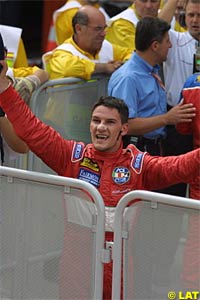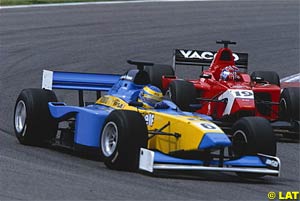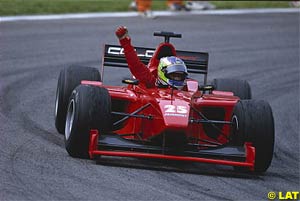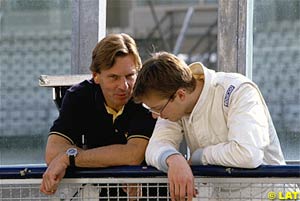
F3000 on Trial
Atlas F1 Senior Writer
While F1's major legal case goes to trial at the FIA's headquarters at the Place de la Concorde in Paris on June 26, 2002, when Ferrari's Team Orders imbroglio is heard by the FIA's World Motor Sports Council, F1's little brother, F3000, has generated its own legal machinations, which will be heard on June 24, 2002, in the High Court of Justice on the Strand in London, the case of Giorgio Pantano vs. Super Nova Racing. Thomas O'Keefe reviews a case that could well be a snapshot of where the law in England stands where it comes to the enforcement of drivers' contracts, a case most Formula One team bosses will be certainly paying attention to
Pantano had driven for the Brussels-based Astromega team in the 2001 season and had won his first F3000 race at the Italian Grand Prix on September 14, 2001. While Astromega had exercised its option to retain Pantano for another year, Pantano and his managers assumed that option could be bought out at the right price and set their sights on switching to Super Nova as the team with the best reputation for engineering what would be the Lola B2/50 car that was to be used in the one-marque series for 2002.
The costs to run one of these F3000 cars for a twelve-race season is astounding, some $900,000 or more and the rub was how to convince Sears to take on Pantano when Pantano and his managers were not in a position to bring that kind of money to the table, although the driver was unquestionably talented. And of course, there was Astromega, which also had to be dealt with as to its option.
But when push came to shove, for reasons that may unfold in High Court on June 24, 2002, Sears gave up the effort to optimize car and driver and went instead with a surer thing: French driver Sebastien Bourdais and Portuguese Tiago Monteiro, who together brought a sufficient budget to see Super Nova through the season, were given the two coveted Super Nova seats. Not wanting to leave Pantano hung out to dry, Sears called down to Paulo Coloni in Italy (an ex-Formula One team) to arrange a drive for Pantano as a member of the Coloni F3000 team. And in the end, Pantano did end up driving for Coloni F3000.
Out on the racetrack this is what has happened thus far. In Brazil, Bourdais qualified on pole for Super Nova but a nail on the Interlagos track led to a puncture which put him out of contention. Pantano finished eighth. Rodrigo Sperafico of the Durango Formula team won the race.
At Imola, Sebastien Bourdais was again on pole and held off Rodrigo Sperafico for 31 laps to win the race. Giorgio Pantano finished third for the Coloni F3000 team after a struggle with Antonio Pizzonia of the Petrobas Junior Team.
In Barcelona, a classic confrontation between Bourdais and Pantano took place and went to the limit. Bourdais had the lead for most of the race but succumbed to pressure from Pantano's Coloni on the very last lap as Bourdais drifted off at turn 7 into the dirt after locking up the brakes. Even the jaded members of the Formula One press corps looked up from their laptops to watch the end of that race.
In Austria, ex-Prost F1 driver Tomas Enge won the race for the Arden International team; Bourdais finished dead last and Pantano finished fourth. As the teams come up on the midpoint in the season and head for Monaco, Pantano is co-leader with Tomas Enge in the drivers' standings and Bourdais is in fourth place.
The race to the courthouse will commence on the Monday after the June 22, 2002 Nurburgring F3000 race. If the case does go to trial it will lay bare a world almost entirely unknown to all but a few motorsports insiders, a world of high flyers and high finance, wannabes, hangerson, mechanics-turned-millionaires, rich kids who can't drive, poor kids who can and the kind of Social Darwinism that, for better or worse, lies behind the careers of those privileged 22 drivers who take to the grid 17 times a year in the rarified world of Formula One. And since the culture, course of dealing and practices in driver/team management in F3000 are not too dissimilar from that holding sway in Formula One, you can be sure that the sporting managers in Formula One will be watching the Pantano case as a snapshot of where the law in England now stands on enforcement of personal services contracts.
Will the same thing happen in Pantano v. Super Nova? It is too soon to say but the parties on both sides seem to be applying the competitiveness of the racetrack to their lawsuit and have geared up impressively for this standoff. Although Pantano's lawyers lost the first round of the litigation in early March 2002, when the High Court denied a request Pantano's barrister made for injunctive relief that would have prohibited Super Nova from putting another driver in Pantano's seat for the 2002 season (which was to begin in Brazil on March 31, 2002), they won on another level because the Court put down the case for an expedited hearing on Pantano's breach of contract claim, which is the June 23rd hearing date.
In accordance with English Civil Law and pre-trial procedure which encourages early settlement of cases, Pantano has made a "so called" Part 36 Settlement Offer of £200,000 to Super Nova which has not been accepted. As we saw in Eddie Irvine's recent case against the Talksport radio station challenging Talksport's use of Irvine's image, the Part 36 mechanism puts in play a bit of a gamble for the parties in a litigation, as Eddie found out when he ultimately won the case but was awarded damages of only $3,000, less than the $7,500 he was offered by Talksport in settlement. Result? Eddie has to reimburse the other side's legal fees in an amount not yet known but certainly more than the amount awarded to Irvine as damages.
Damages is what Pantano v. Super Nova is all about: how do you put a price on the damage to the career of a young driver that results from a breach of contract, if that is what happened here. What kind of numbers are we talking about? According to Lars-Christian Brask, a Danish investment banker based in London who is funding much of Pantano's career, the consequential damages to which Super Nova is now exposed could amount to much more than the original numbers being thrown about when Pantano and Super Nova were negotiating terms for the 2002 season.
Why? Because once Pantano was blocked in becoming a Super Nova driver, he and his managers then set about the business of re-shaping the heretofore backmarker Coloni F3000 team into a winning team, to the point where Coloni is now at the sharp end of the F3000 grid. That cost money and Team Pantano intends to bill Super Nova for those costs as part of its damages claim.
Coloni is a team founded by Enzo Coloni, himself a former Italian Formula Three Champion. After several years of successful racing in European and Italian Formula Three, including Ivan Capelli winning the 1983 Monaco Formula Three race which was then and still is the Holy Grail along with Macau for those with their eyes on Formula One, Coloni stepped up to Formula One at the end of 1987 and persisted until 1991 with a succession of cars and drivers that never managed to get very far, struggling to qualify in the kit car-cum-Cosworth era when sometimes 30 cars took to the grid. In the end, the undercapitalized Coloni Formula One team qualified for 13 races and its highest finish was an eighth at Canada in 1988, when Gabriele Tarquini drove for the team.
Enter Team Pantano (formally known as Pantano Motorsport Ltd.), which invested in the Coloni team and in their driver to make it a front rank team, bringing in engine tuners with experience from Formula One and a sports psychologist to work with Giorgio to help him recover from the jarring travails of pre-season and to develop a winning mind-set. Brask and Pantano plan to introduce as their measure of damages what it has cost Team Pantano to put Giorgio and the Coloni F3000 team in the position he would have been had he been allowed to take his seat at Super Nova in the first instance. If Pantano's theory of damages is successful, it could wind up that David Sears ends up funding two teams this year, his own and Coloni F3000!
What is Super Nova's rebuttal to Pantano's claims? David Sears continues to maintain that he was never told by Pantano's managers that Pantano had a pre-existing contract with Astromega that would have to be bought out for Pantano to join Super Nova. The implication is that had Sears known of the Astromega option he would not have entered into a contract with Pantano, the contract that is now the subject of the breach of contract litigation.
Moreover, Sears asserts that once Pantano's lawyers took the extraordinary step of trying to obtain a "negative injunction" that would have prohibited Sears from substituting another driver for Pantano in the Super Nova seat, there was a breakdown of trust between the parties and a poisoning of the relationship that meant they could never work together as a team. Sears also did make the initial calls to Coloni F3000 to mitigate any damage caused by his substitution of drivers at Super Nova. Finally, Sears argues that the one-make F3000 series with a new car and new regulations has levelled the playing field to the point that being on a Coloni F3000 team is little different for a driver than being with a Super Nova team. And ironically, the results of the F3000 season thus far bear out Sears' argument, with Super Nova winning only one race, Arden International winning one, Coloni one and the Durango Formula team one.
The vast majority of cases in courts worldwide get settled and in all likelihood this one will get settled too, probably in the quiet but famous little town of Nurburg, Germany, in the paddock on Saturday afternoon, June 22, 2002, after the F3000 race has been run, when the principals of Super Nova and Team Pantano will strike a deal and advise their lawyers to stop the meters running in London. The high-priced lawyers for both sides will notify Judge Henriques on the Strand in High Court that the parties have reached an "amicable settlement" and the Judge will have a free calendar that Monday morning.
Regardless of the outcome of the case, will being so litigious ultimately tarnish Pantano and his management as a contentious group to do business with, thus undermining the ultimate goal of Team Pantano, getting Pantano a seat in Formula One? You would think so at first blush but it is not necessarily so in Formula One, where we have become accustomed to seeing a spate of driver litigations that have proliferated over the years, the most recent case involving Jordan and Heinz-Harald Frentzen. Even Michael Schumacher, who has certainly done well since, back in 1991 was the subject of threatened litigation when Eddie Jordan found his promising recruit being seduced away by Benetton.
Indeed, to some, what Pantano is enduring might well be regarded as a badge of honor in the topsy-turvy world of Formula One where grit, steely determination and the exercise of power are central character traits of all the top drivers and teams. One thing is for sure; whoever foots the bill for this episode, you can be sure that for certain more lawyers than ever will be prowling the paddock advising drivers and teams to "get it in writing" to avoid the thicket represented by Giorgio Pantano v. Super Nova. Otherwise, it is "Oye, Oye, the Court is now in session."
Turning back to Formula One, the most biting question put by the frenzied media to Michael Schumacher in Austria 2002 in the post-race press conference was "do you want to be known as the best driver, or the driver with the best contract?" The question went unanswered by Schumacher that day but Giorgio Pantano may yet have the answer to this question for himself: the answer is "Both."
Giorgio Pantano is one of the hottest drivers coming up through the ranks in F3000, the feeder series for Formula One, and in the run-up to the 2002 season, Pantano and his managers, Lars-Christian Brask and Alf Boarer, thought they had negotiated a ride for Pantano with the Super Nova team run by David Sears. Super Nova was where Juan Pablo Montoya and Mark Webber made their mark and is badged this year as a junior Renault team. Why Super Nova? Because although it had not won a drivers' title since JPM's 1998 season with them, Super Nova is still regarded as the Gold Standard for F3000, having won three Championships, scored the most points, led the most laps, the lot.
 As one season blended into another and as the dimensions of sponsorship fallout from September 11th took hold on all concerned, the parties circled one another in a quest to match arguably the best team, Super Nova, with arguably the best driver, Pantano. Jets criss-crossed Europe several times, meetings in the paddock took place and contracts were signed in the effort to put Pantano in a Super Nova Lola for 2002.
As one season blended into another and as the dimensions of sponsorship fallout from September 11th took hold on all concerned, the parties circled one another in a quest to match arguably the best team, Super Nova, with arguably the best driver, Pantano. Jets criss-crossed Europe several times, meetings in the paddock took place and contracts were signed in the effort to put Pantano in a Super Nova Lola for 2002.
 Formula One almost got an answer to that question in the Adrian Newey/Bobby Rahal episode of 2001, but Jaguar and McLaren both apparently concluded that the stakes were too high and settled the matter on the courthouse steps with the terms of settlement - who paid what to whom - shrouded in secrecy.
Formula One almost got an answer to that question in the Adrian Newey/Bobby Rahal episode of 2001, but Jaguar and McLaren both apparently concluded that the stakes were too high and settled the matter on the courthouse steps with the terms of settlement - who paid what to whom - shrouded in secrecy.
 In the lower formulas, Coloni had achieved some success, winning not only the European and Italian Formula Three Championships in 1983 with Capelli but also the Italian Formula Three Championship in 1986 with Nicola Larini. But in the current era, the Coloni F3000 team Pantano was joining was no Super Nova. In the last decade, Coloni F3000 had never won a race while Super Nova had won two dozen of them.
In the lower formulas, Coloni had achieved some success, winning not only the European and Italian Formula Three Championships in 1983 with Capelli but also the Italian Formula Three Championship in 1986 with Nicola Larini. But in the current era, the Coloni F3000 team Pantano was joining was no Super Nova. In the last decade, Coloni F3000 had never won a race while Super Nova had won two dozen of them.
 Who will pay what to whom? In the Jaguar/McLaren/Newey case we heard rumours but never get confirmation of the amounts that changed hands (from McLaren to Jaguar we suspect) but the minimum standard for payment in these cases amongst heavy-hitters becomes legal fees, which in the Pantano v. Super Nova case must be enormous by now since lawyers from England to Italy are working to prepare the case for trial. Will one conceivable way of settling the case - putting Pantano in the Super Nova seat he once so assiduously sought - ever happen? This is the one point on which both sides agree: no way, after all this. It is down to a matter of money.
Who will pay what to whom? In the Jaguar/McLaren/Newey case we heard rumours but never get confirmation of the amounts that changed hands (from McLaren to Jaguar we suspect) but the minimum standard for payment in these cases amongst heavy-hitters becomes legal fees, which in the Pantano v. Super Nova case must be enormous by now since lawyers from England to Italy are working to prepare the case for trial. Will one conceivable way of settling the case - putting Pantano in the Super Nova seat he once so assiduously sought - ever happen? This is the one point on which both sides agree: no way, after all this. It is down to a matter of money.
Please Contact Us for permission to republish this or any other material from Atlas F1.
|
Volume 8, Issue 22
Atlas F1 Exclusive
Exclusive Interview with Webber
Ann Bradshaw: View from the Paddock
Articles
F3000 on Trial
Monaco GP Review
Monaco GP Review
Streetwise
Coulthard's World
Monaco GP - Technical Review
Stats Center
Qualifying Differentials
SuperStats
Charts Center
Columns
Season Strokes
Elsewhere in Racing
The Grapevine
> Homepage |